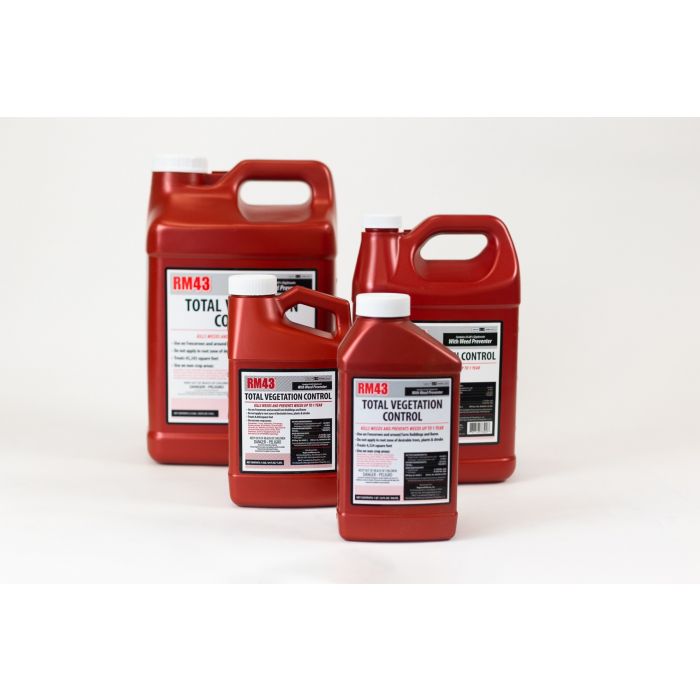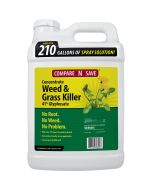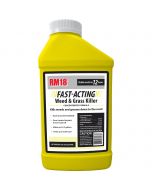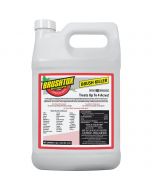SERIOUS WEED CONTROL™
Serious Weed Control™ For Up To A Year!
RM43 is your solution for total vegetation control on bare ground or for spot control of brush, vines and more than 150 weeds. It kills existing weeds and prevents future growth on walkways, roadsides, fence lines and any place you want to keep free from invasive plants.
RM43 Total Vegetation Control is a combination of two herbicides and a surfactant. Glyphosate kills the weeds and imazapyr prevents new growth. It is rainfast in two hours and there are no entry restrictions to sprayed areas for pets or people after the spray has dried.
How Much Do I Need?
| 32-ounce | 64-ounce | 1-gallon | 2.5-gallon | |
| Total Vegetation Control: Treats up to | 4,324 sq ft | 8,648 sq ft | 17,297 sq ft | 43,243 sq ft |
| Spot Treatment: Makes up to | 5 gal | 10 gal | 21 gal | 53 gal |
Where to use:
| Roadsides | Warehouse areas | Brick walks |
| Curbs | Fencerows | Gravel paths |
| Sidewalks | Around farm buildings and barns | Farm premises |
| Driveways | Agricultural uncultivated areas | Vacant lots |
| Parking areas | Farm yards | For establishment and maintenance of wildlife openings |
When to use:
Apply to bare ground or when weeds are present. If weeds are taller than six inches, mow or cut down weeds, remove debris and allow for 2 weeks of new growth before treatment.
If woody vines or brush is mowed or cut, wait until full leaf formation before treatment.
To prevent growth of weeds under asphalt driveways, play areas, tennis courts and parking areas, apply this product before laying surfacing materials. Treat area uniformly to maximize results. Re-treatment every 6 to 8 months may be necessary in areas of heavy rainfall.
How to use:
For Total Vegetation Control (Bare Ground)
Use hand-operated spray equipment such as backpack sprayers, pump-up sprayers or sprinkling cans, or ATV/tractor-mounted sprayers. Mix 7.4 fl. oz. (0.46 pints) of product with water to produce 1 to 10 gallons of spray solution. Optimum performance will be achieved by applying to actively growing weeds in early summer. Uniformly spray the mix over areas where total vegetation control and bare ground is desired. 7.4 fl. oz. of product in 1 to 10 gallons of spray solution should be applied to 1,000 square feet. Maximum application rate of this product is 2.5 gallons per acre per year (7.4 fl. oz. per 1,000 sq. ft. per year).
For Spot Control of Brush, Vines and Weeds
Use hand-operated spray equipment such as backpack sprayers, pump-up sprayers or sprinkling cans, or ATV/tractor-mounted sprayers. Mix 6 oz. of product per 1 gallon of spray solution. Thoroughly and uniformly spray foliage of woody plants to wet. For optimum performance:
- Apply to actively growing brush, vines and weeds.
- Woody brush and vines are controlled better in late summer and fall after fruit formation.
- If woody vines and brush are mowed or cut, wait until full leaf formation before treatment.
- Do not cut or mow brush, vines or perennial weeds for 2 months following treatment.
- Maximum application rate of this product is 2.5 gallons per acre per year (7.4 fl. oz. per 1,000 sq. ft. per year).
Precautions:
- Do not apply this product in a way that will contact workers or other persons, either directly or through drift. Only protected handlers may be in the area during application.
- Do not enter or allow others to enter treated areas until sprays have dried.
- Do not use on feed or food crops. Keep people and pets out of the area during application.
- For any requirements specific to your state or tribe, consult the agency responsible for pesticide regulation.
Active Ingredients:
| Glyphosate, isopropylamine salt | 43.68% |
| Imazapyr, isopropylamine salt | 0.78% |
| Other Ingredients | 55.54% |
| Total | 100.00% |
Product Label:
32 ounce | 64 ounce | 1 gallon | 2.5 gallon
Disclaimer:
It is a violation of Federal law to use this product in a manner inconsistent with its labeling. Read the entire label before each use. Use only according to label instructions.
See the complete label for specific use rates and detailed instructions.
Consult the Safety Data Sheet (SDS) for important safety information.




